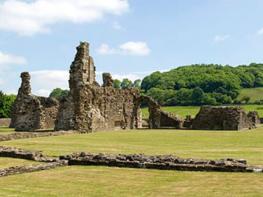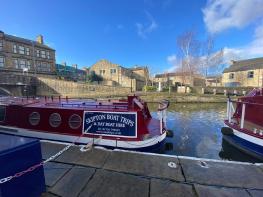In the picture postcard village of Barley, Pendle Holiday Cottages are surrounded by beautiful…
The Pendle Way from Barley

5 miles (8kms)
About the walk
This walk commences in the commendable village of Barley, which, in 1324, was known as Barelegh – an infertile lea or meadow. It follows much of the route of the Pendle Way, signposted by a black witch flying on her broomstick across a yellow sky. You climb gently past the Lower Ogden Reservoir and the Upper Ogden Reservoir to the steep sided Ogden Clough, then strike off up Boar Clough where the vegetation is indicative of acidic peat: ferns uncurl above bilberry shrubs and verdant patches of moss and white bog cotton complete the patchwork. The going is soft on the peaty ground across Barley Moor to the summit of Pendle Hill, and such is the spellbinding spirit of the area that dark figures on the skyline above could easily be mistaken for witches! The descent down the Big End is steep but quick, followed by a lovely tree-lined walk beside a tiny beck to return to Barley.
Referred to as a sleeping lion, Pendle Hill slopes gently up the lion's back to fall away sharply down the face, known as the Big End. The summit affords a spectacular bird's-eye view over the Ribble Valley to Yorkshire's Three Peaks in the north and Lancashire's cotton towns of Padiham and Burnley nestling beneath the Pennine hills to the south. At 1,827ft (557m), the hill is constructed of gritstone and limestone, a combination that strongly influences the contrasting Pendle scenery. On the summit is the Beacon, a Bronze Age burial mound thought to be possibly 7,000 years old. It was Pendle Hill that George Fox climbed in 1652 and where he had his vision of enlightenment that led him to found the Quaker movement. 'I was moved of the Lord to go up the top of it, which I did with much ado, as it was so very steep and high.
'The name Pendle Hill means 'Hill Hill Hill'. The way this came about is typical of the convoluted history behind so many English place names. If you lived below Pendle, you might well call it simply 'the Hill', and early Celtic inhabitants did just that - 'Pen'. Later incomers, not realising this, called it Pendle, meaning 'the hill called Pen'. This meaning too became obscured, and the name was later applied to the whole district. The Wild High Moors. Pendle is also associated with witches.
Pendle Witches
‘Witch’ comes from the Anglo-Saxon word ‘wicca’, meaning ‘the wise ones’ and were thought to possess magical powers. The Demdikes of Malkin Tower and the Chattox’s of Higham were matriarchal families who lived in the Pendle area in the early 17th century. These self-confessed witches were accused of turning cattle into cats, turning the ale in the inn at Higham sour and bewitching the landlord’s son to death, and paralysing a pedlar on the road to Colne. These were difficult times for independent women, witches or not, and 19 Pendle residents were eventually taken to the gaol at Lancaster Castle where they were charged with witchcraft. The Witch Trial took place in August 1612 and, after some dubious confessions, resulted in the execution by hanging of seven women and two men. The story has been fictionalised in many novels including Robert Neill’s Mist Over Pendle (1951) and The Familiars (2019) by Stacey Halls.
Walk directions
Exit the car park, turn right and cross the main road to a bridlepath signposted 'Ogden Clough', Pass the three-storey Barley Green Farmhouse with its interesting row of corbels, proceed between circular gateposts, and pass a Water Works building on the right. Continue to a climb beside the grassy dam of the lower reservoir, where the metalled lane gives way to an unmade track. Continue straight ahead and join the Pendle Way as it leaves Fell Wood on the left; here you get your first clear view of Pendle Hill up to the right. Keep straight ahead to the bottom of the upper reservoir, cross a stile and ascend the track beside the dam. Follow the Pendle Way alongside the reservoir and up Ogden Clough, passing through a kissing gate into open country. The path is obvious to another kissing gate, where the route bears right up a stony path that soon swings left and follows the contours.
Cross the stream in Boar Clough. An obvious, badly eroded, path climbs up to the right. The worst of this can be avoided by continuing ahead a short distance, then climbing grassy slopes directly to a marker post. Either way is steep at first but soon gives way to a more gentle climb on soft ground along a cairn-marked route over Barley Moor to the summit trig point.
Walk along the summit escarpment to a wall with a ladder stile. Go right, staying this side of the wall, to a carved upright stone marking the Pendle Way; strike sharp right and descend steeply down the stone-stepped path.
Go right after the kissing gate at the bottom, signposted 'Barley', rounding the back of Pendle House to a yellow-topped post and bear left through another gate. Drop down the meadow, with a wall on the left, and through a gate at the bottom leading into another meadow. Keep on down to a kissing gate and walk through newly-planted trees to another gate near a farm building. Turn right along a track as signposted, then bear left through the grounds of Brown House to join a pretty tree-lined path between a stream and a wall.
Proceed through gates and over footbridges to reach a narrow cobbled lane. Exit onto a metalled road and turn left through the grounds of Ing Ends.
Soon cross a yellow waymarked footbridge on the right and bear left through a meadow and gates to pick up the stream on the left. On reaching the main road in Barley opposite the Primitive Methodist church, turn right through the village to a Pendle Way marker leading you off the road, through the playground and park to the car park beyond.
Additional information
Defined paths, lots of kissing gates, one stile
Wooded valleys, moorland, hilltop views
On lead near livestock on moorland
OS Explorer OL21 South Pennines
Pay-and-display car park in Barley
At car park
WALKING IN SAFETY
Read our tips to look after yourself and the environment when following this walk.
Find out more
Also in the area
About the area
Discover Lancashire
Lancashire was at the centre of the British cotton industry in the 19th century, which lead to the urbanization of great tracts of the area. The cotton boom came and went, but the industrial profile remains. Lancashire’s resorts, Blackpool, Southport and Morecambe Bay, were originally developed to meet the leisure needs of the cotton mill town workers. Blackpool is the biggest and brashest, celebrated for it tower, miles of promenade, and the coloured light ‘illuminations’. Amusements are taken very seriously here, day and night, and visitors can be entertained in a thousand different ways.
The former county town, Lancaster, boasts one of the younger English universities, dating from 1964. Other towns built up to accommodate the mill-workers with back-to-back terraced houses, are Burnley, Blackburn, Rochdale and Accrington. To get out of town, you can head for the Pennines, the ‘backbone of England’, a series of hills stretching from the Peak District National Park to the Scottish borders. To the north of the country is the Forest of Bowland, which despite its name is fairly open country, high up, with great views.
Nearby stays
Restaurants and Pubs
Nearby experiences
Recommended things to do
Why choose Rated Trips?
Your trusted guide to rated places across the UK
The best coverage
Discover more than 15,000 professionally rated places to stay, eat and visit from across the UK and Ireland.
Quality assured
Choose a place to stay safe in the knowledge that it has been expertly assessed by trained assessors.
Plan your next trip
Search by location or the type of place you're visiting to find your next ideal holiday experience.
Travel inspiration
Read our articles, city guides and recommended things to do for inspiration. We're here to help you explore the UK.













